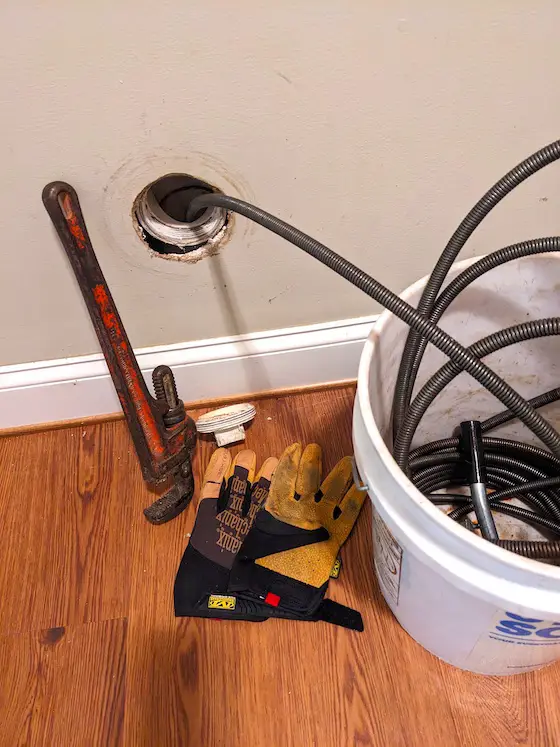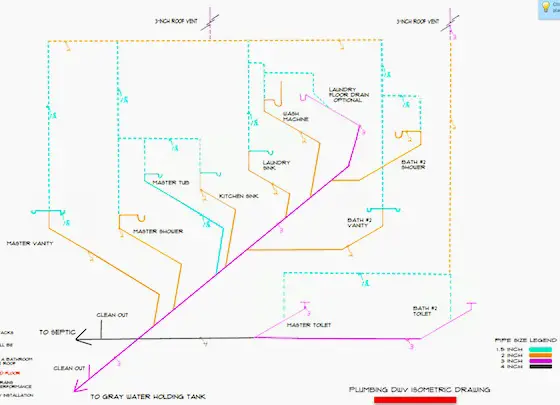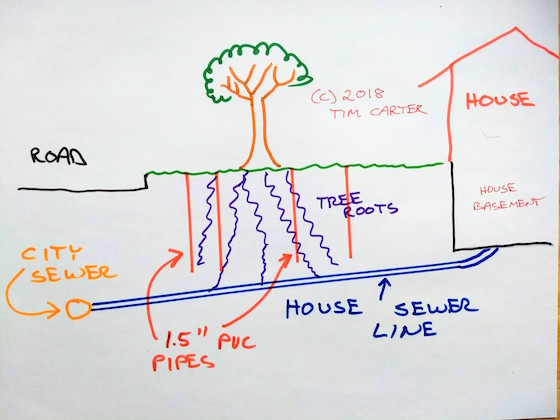How to Unclog Drains in Minutes

A pipe wrench, an inexpensive 50-foot metal drain-cleaning snake, and some gloves might save your bacon and $500.00. Copyright 2023 Tim Carter
How to Unclog Drains in Minutes - Save Hundreds of Dollars
I’ve been a master plumber for over four decades in addition to building and remodeling homes. I was attracted to plumbing because it’s a fascinating three-dimensional puzzle of interconnected drain, waste, and vent pipes. Most are invisible behind the walls and ceilings in your home. I also love drawing riser diagrams that show all these pipes. You need one of these to obtain a plumbing permit. Go here - opens in a new window - if you need me to draw your riser diagram.

Here's a riser isometric drawing showing the separation of gray water from black water in a home. CLICK or TAP HERE to have me draw your riser diagram.
Poor Pipe Layout Creates Clogs
Drain pipes of all sizes in your home can clog for many reasons. It’s vital the layout of the pipes have as few changes of direction as possible so the wastewater gets out of your home with minimal friction loss. One hopes your plumber installed the pipes with sufficient slope so the water and solids make it to the city sewer or your septic tank with no issues.
If the pipes are not at fault for clogs, then it’s often human error or oversight that creates a clog. For example, your kitchen drain and even the primary building drain may be clogged with grease. I’ve seen grease clogs that run for twenty feet. The pipe is choked off with a disgusting semi-solid mass that resembles a shortening you might use for baking.
Grease is a Major Clog Cause
You can prevent grease clogs with just a small amount of effort. Start saving paper towels that you might use to dry your hands or use to clean a countertop. Once dry, store them in a box under your sink. Use these towels to sop up grease from plates, pans, skillets, bowls, etc. Toss these grease-soaked towels in the garbage.
After you wash grease-covered items, run hot water in your sink for one minute. Better yet, fill your sink with hot water and then pull out the stopper. This massive amount of hot water fills the entire horizontal branch arm pipe that drains your sink. As the water cascades down the vertical stack it creates a turbulent whirlpool that rinses any liquid grease off the sides of the pipes. Just as the sink drains out, flush a nearby toilet to try to force all the water into the city sewer or your septic tank.
Cosmetics & Hair in Bathroom Sinks
Bathroom sinks commonly get clogged with hair and cosmetic ingredients. Quite often the clog is located in the short pipe between the bottom of the sink and the p-trap below in the cabinet. The sink stopper and the control rod that makes the stopper go up and down are choke points within the tailpiece pipe just under the sink.
It’s easy to remove the control rod by turning a nut on the tailpiece pipe. Once you have the rod pulled out, you can pull the stopper up. Be prepared to be grossed out. The black biofilm goop needs to be cleaned off the stopper mechanism as well as the inside of the pipe between the sink and the p-trap. Use a long bottle brush that’s just slightly larger in diameter than the drain pipe.
Put a piece of duct tape over the hole where the control rod entered the tailpiece. This will prevent water from entering your cabinet as you run water in the sink while you make the bottle brush go up and down. Check your progress with a flashlight until the drain pipe is nice and clean.
High-Quality Toilet Paper & Low-Flush Toilets Create Clogs
High-quality toilet paper mixed with low-flush toilets is another common source of clogs. Drain pipes in older homes were designed decades ago knowing that toilets of old would send 3.5 gallons of water into the system to transport the waste. Now you have less than 50 percent of that. Remember your high school physics? Force equals mass time acceleration. The water mass has been reduced by half so the force of the water moving down the pipes has, by default, been reduced as well.
Low-flush toilets, in my opinion, should have never been thrust upon all of us. A vast majority of the USA doesn’t have a water shortage. Cities with municipal sewage treatment plants put back into the river the same amount of water each day as is being taken out upstream for drinking water. If you choose to live in a place where it rarely rains, then you can use a low-flush toilet. As for me, I’d give my eye teeth to have back my old toilets.
DIY Drain Cleaning
Should you have a substantial clog in the 4-inch primary building drain in your crawlspace or under a concrete slab, you can often remove the blockage in the pipe. You just need a pipe wrench, a 50 or 100-foot drain-cleaning snake, and a great pair of gloves. There are plenty of videos on YouTube that show you how to use a manual drain-cleaning snake. If you have no luck, then call in the pros who have power drain augers.
If tree roots are causing your clogs, read my past columns that show you how to stop the tree roots from entering your pipes. It’s a DIY trick that I’ve used for years that works every time. Here are the columns. They all open in new windows:
Tree Root Removal in Sewer Lines
Magic Small Pipes Kill Tree Roots

The red vertical lines are small 1.5-inch PVC pipes. Fill them with copper sulfate crystals and hot water and no more tree roots sewer line problems! Copyright 2018 Tim Carter
Column 1534
One Response to How to Unclog Drains in Minutes